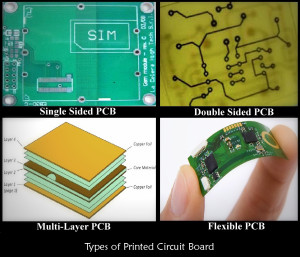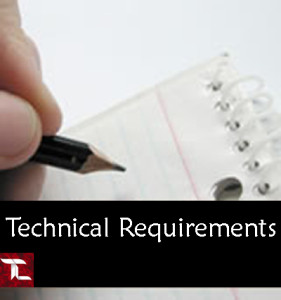I thought of this topic for our discussion today as this is the most important topic related to any electronic field. We all are surrounded by the world of various electronic equipments and devices. All this electronic equipments have the most important component named as PCB (Printed Circuit Board). These PCB’s are also refers to as the ‘heart of any electronic stuff’. A PCB is a mechanical chip which connects all the electronics and electrical components with the help of a set of conductive materials. The PCB needs to be very accurate with its design and performance parameters. The specifications and design of the PCB is totally dependent on the manufacturer. The PCB layout (design) is made with appropriate calculations and design steps.
Let’s make ourselves more familiar to a PCB by discussing its types and requirements.
Types of Printed Circuit Board:-
1.) Single Sided PCB
- Single sided means wiring is available only on one side of the insulating substrate.
- The side which contains the circuit pattern is called solder side whereas the other side is called as ‘component side’.
- This type of boards, are usually used in case of simple circuitry and where manufacturing costs are to be kept minimum.
- The single sided PCB are manufactured using ‘print and etch’ method or by ‘die cut’ method.
2.) Double Sided PCB
- Wiring patterns on both sides of the insulating material (i.e. circuit pattern is available both on the components side and solder side)
- Jumpers can be used if required.
3.) Multilayer PCB
- These PCB’s are made up by two or more PCB layers which are stacked together with reliable and predefined connections.
- It provides more room for components hence two sided assembly can be avoided while designing.
- Same functions in a smaller PCB can be made possible using this type.
- These multilayered PCB’s, help in considerable saving of space and shielding of many components simultaneously.
4.) Flexible PCB
- Flexible PCB’s can be shaped to fit where no other design can fit.
- These type of boards are a hybrid of ordinary printed circuit boards and round wire, exhibiting benefits of each.
- These provide unlimited freedom of packaging geometry while retaining the density and repeatability of printed circuits with great precision..
- It consists of flexible films and thin layers of conductive circuit traces.
- They constitute of the base flexible-circuit laminate, which is utilized to interconnect electronic devices – such as the LCD screen and keyboard of a laptop.
Technical requirements:-
The technical requirements which are likely to affect the design of electrical equipment with respect to PCB are as follows
1. Mechanical Design Requirements:-
- Mechanical design requirements include Size of board which should be accurate according to the requirement.
- Shape of board Weight should be compact which may be rectangle, square depending on the application.
- Location of components should be proper with the use of jumpers and track spacing.
2. Electrical Design Requirements:-
- Circuit Function should be clear with voltage levels and other specifications
- Wiring distribution should be proper where needed.
- Selection of components in according to electrical ratings is very important factor.
3. Environmental Design Requirements:-
- The mechanical shock due to overload, etc should be minimized
- The chip should be designed in such a way that it can withstand vibrations
- The PCB should work in extreme temperatures, such tests should be carried out before actual implementation.
- Salt and fungus, corrosion proofing should be done.
In the next part we will deal with more details and designing steps of PCB

